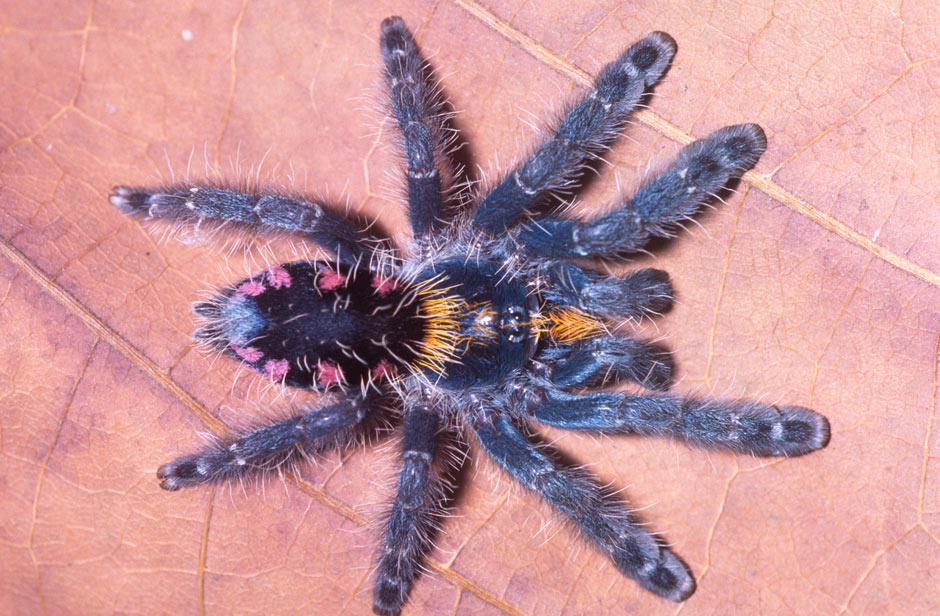Welcome to DU!
The truly grassroots left-of-center political community where regular people, not algorithms, drive the discussions and set the standards.
Join the community:
Create a free account
Support DU (and get rid of ads!):
Become a Star Member
Latest Breaking News
General Discussion
The DU Lounge
All Forums
Issue Forums
Culture Forums
Alliance Forums
Region Forums
Support Forums
Help & Search
Environment & Energy
Related: About this forumNew to nature No 107: Typhochlaena costae
http://www.guardian.co.uk/science/2013/jun/23/new-to-nature-tarantula-typhochlaena-costae
The 'spectacular' colouration of Typhochlaena costae. Photograph: Rogério Bertani
There is a story, perhaps apocryphal, that Harvard professor and mycologist Roland Thaxter once gave a public lecture on the Laboulbeniales, an enigmatic group of fungi that grow on the integument of insects. A woman in the audience is said to have asked: "Professor Thaxter, this is all interesting, but of what value is it to mankind?" to which Thaxter replied: "None, thank God!"
Much species exploration is undertaken out of pure curiosity about the living world, so it is easy to understand why progress in some obscure taxa has been slow. Other groups, however, are so significant that neglect of their taxonomy is inexplicable. Theraphosidae is one such taxon.
The theraphosids include about one-third of the 2,693 documented species of mygalomorphs – tarantulas and funnel web spiders. In the intricate sub-webs of invertebrate animals in many terrestrial ecosystems these are "top" predators, making them of special interest to ecology. They have been used as model organisms in such diverse studies as molecular biology, biochemistry, pharmacology, ethology and biogeography, and they have a large and devoted following in the international pet trade. Yet their taxonomy, natural history and phylogeny remain incompletely studied.
Professor Rogério Bertani, of the Instituto Butantan, São Paulo, recently revised three theraphosid genera, improving our knowledge of their species diversity, phylogeny, and geographic and natural histories, and describing nine species as new. Although there were more interesting natural history stories attached to some of his other new species, I could not get past the sheer beauty of one, Typhochlaena costae. Its spectacular colouration, long golden setae (hairs) over the chelicerae (jaws), carapace and abdomen are chelicerae-dropping gorgeous.
***not exactly 'new to nature' -- but point taken.
InfoView thread info, including edit history
TrashPut this thread in your Trash Can (My DU » Trash Can)
BookmarkAdd this thread to your Bookmarks (My DU » Bookmarks)
2 replies, 1709 views
ShareGet links to this post and/or share on social media
AlertAlert this post for a rule violation
PowersThere are no powers you can use on this post
EditCannot edit other people's posts
ReplyReply to this post
EditCannot edit other people's posts
Rec (3)
ReplyReply to this post
2 replies
 = new reply since forum marked as read
Highlight:
NoneDon't highlight anything
5 newestHighlight 5 most recent replies
= new reply since forum marked as read
Highlight:
NoneDon't highlight anything
5 newestHighlight 5 most recent replies
New to nature No 107: Typhochlaena costae (Original Post)
xchrom
Jun 2013
OP
hootinholler
(26,449 posts)1. Pretty! But poisonous? n/t
xchrom
(108,903 posts)2. tarantulas aren't so poisonous to us -- generally speaking -- and it's a tarantula -
so i'ma gonna go with that.